Torque Distribution Based on Dynamic Programming Algorithm for Four In-Wheel Motor Drive Electric Vehicle Considering Energy Efficiency Optimization
Abstract
1. Introduction
- (1)
- A torque distribution method with the comprehensive goals of optimal torque distribution and energy efficiency considering economy through energy efficiency is proposed in this paper.
- (2)
- The DP control algorithm is utilized for toque distribution between the front and rear in-wheel motors to obtain optimal torque distribution and energy efficiency in the 4IWMD EV.
- (3)
- The proposed torque distribution based on the DP algorithm for the 4IWMD electric vehicle considering energy efficiency optimization is effectively verified through simulation and experiment under the NEDC, WLTC and IM240 driving cycles.
2. IWMD Electric Vehicle Model
2.1. Vehicle Dynamics Model
2.2. In-Wheel Motor Model
2.3. Battery Model
3. Torque Distribution Strategies
3.1. Torque Optimization Approach
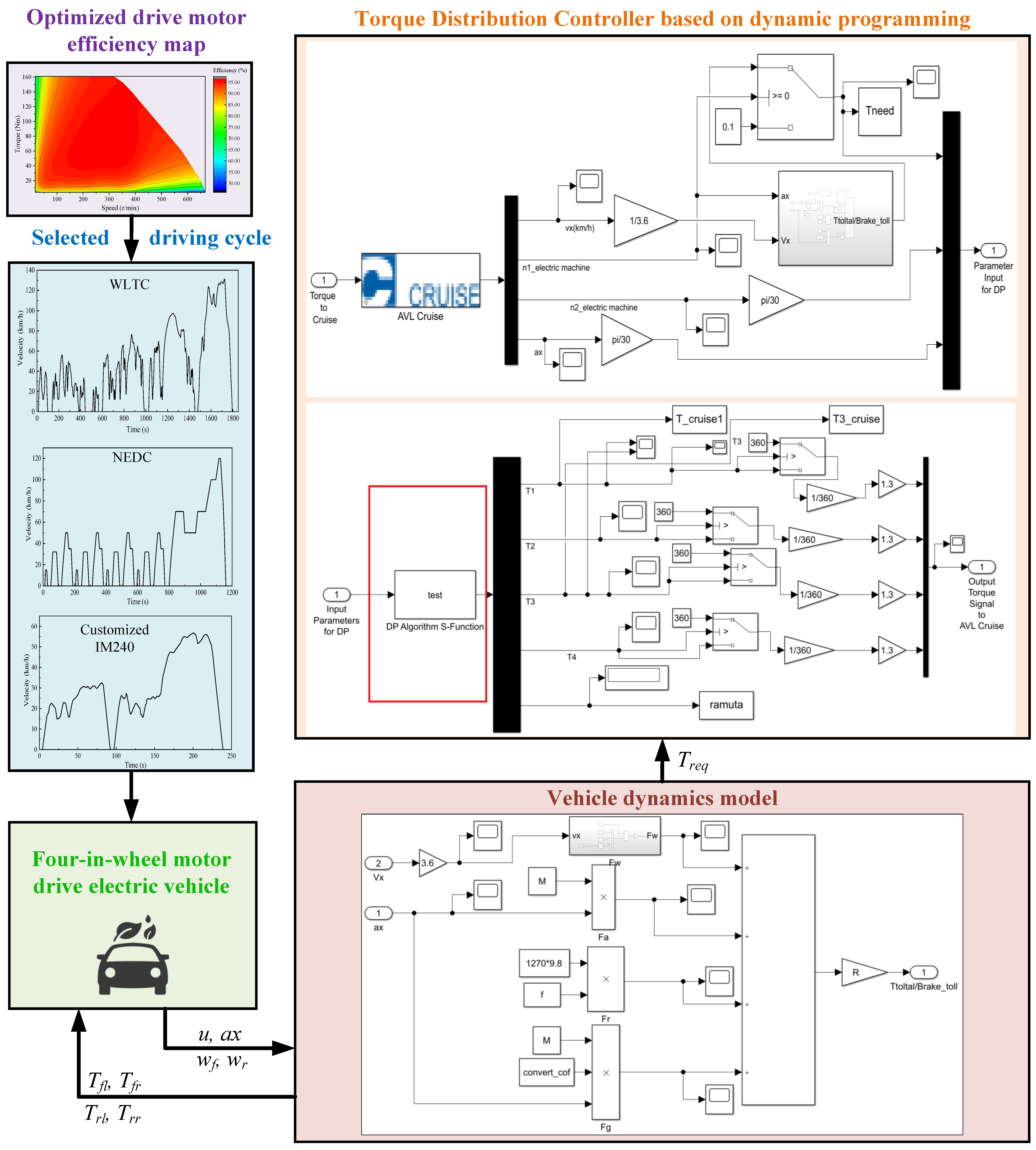
3.2. Torque Distribution Based on DP
4. Simulation Results and Analysis
4.1. WLTC Driving Cycle
4.2. NEDC Driving Cycle
4.3. Customized IM240 Driving Cycle
4.4. Energy Saving Analysis
5. Experimental Validation
5.1. WLTC Drive Cycle
5.2. NEDC Drive Cycle
5.3. Customized IM240 Driving Cycle
5.4. Energy Saving Analysis
6. Conclusions
Author Contributions
Funding
Data Availability Statement
Conflicts of Interest
References
- Li, B.; Goodarzi, A.; Khajepour, A.; Chen, S.K.; Litkouhi, B. An optimal torque distribution control strategy for four-independent wheel drive electric vehicles. Veh. Syst. Dyn. 2015, 53, 1172–1189. [Google Scholar] [CrossRef]
- Joa, E.; Park, K.; Koh, Y.; Yi, K.; Kim, K. A tyre slip-based integrated chassis control of front/rear traction distribution and four-wheel independent brake from moderate driving to limit handling. Veh. Syst. Dyn. 2018, 56, 579–603. [Google Scholar] [CrossRef]
- Park, G.; Han, K.; Nam, K.; Kim, H.; Choi, S.B. Torque Vectoring Algorithm of Electronic-Four-Wheel Drive Vehicles for Enhancement of Cornering Performance. IEEE Trans. Veh. Technol. 2020, 69, 3668–3679. [Google Scholar] [CrossRef]
- Deng, H.; Zhao, Y.; Feng, S.; Wang, Q.; Lin, F. Torque Vectoring Algorithm Based on Mechanical Elastic Electric Wheels with Consideration of the Stability and Economy. Energy 2021, 219, 119643. [Google Scholar] [CrossRef]
- Chatzikomis, C.; Zanchetta, M.; Gruber, P.; Sorniotti, A.; Modic, B.; Motaln, T.; Blagotinsek, L.; Gotovac, G. An energy-efficient torque-vectoring algorithm for electric vehicles with multiple motors. Mech. Syst. Signal Process. 2019, 128, 655–673. [Google Scholar] [CrossRef]
- Debada, E.; Marcos, D.; Montero, C.; Camacho, E.F.; Bordons, C.; Ridao, M.A. Torque distribution strategy for a four In-wheel fully electric car. Jorn. Autom. 2015, 517–525. Available online: https://idus.us.es/handle/11441/92138 (accessed on 6 September 2022).
- Mokhiamar, O.; Abe, M. How the four wheels should share forces in an optimum cooperative chassis control. Control Eng. Pract. 2006, 14, 295–304. [Google Scholar] [CrossRef]
- Yong, L.; Deng, H.; Xing, X.; Jiang, H. Review on torque distribution strategies for four in-wheel motor drive electric vehicles. IOP Conf. Ser. Mater. Sci. Eng. 2018, 394, 042041. [Google Scholar]
- Wang, Y.; Su, Y. A research for brake strategy based on fuzzy control in pure electric vehicles. In Proceedings of the 2015 4th International Conference on Computer Science and Network Technology (ICCSNT), Harbin, China, 19–20 December 2015; pp. 689–693. [Google Scholar]
- Wang, B.; Huang, X.; Wang, J.; Guo, X.; Zhu, X. A robust wheel slip control design for in-wheel-motor-driven electric vehicles with hydraulic and regenerative braking systems. In Proceedings of the 2014 IEEE American Control Conference, Portland, OR, USA, 4–6 June 2014; pp. 3225–3230. [Google Scholar]
- Prajeesh, K.; Beevi, M.W. An Efficient Regenerative Braking System for BLDCM driven Electric Vehicles. In Proceedings of the 2018 4th International Conference for Convergence in Technology (I2CT), Mangalore, India, 27–28 October 2018; pp. 1–5. [Google Scholar]
- Hannan, M.A.; Hoque, M.M.; Mohamed, A.; Ayob, A. Review of energy storage systems for electric vehicle applications: Issues and challenges. Renew. Sustain. Energy Rev. 2017, 69, 771–789. [Google Scholar] [CrossRef]
- Tie, S.F.; Tan, C.W. A review of energy sources and energy management system in electric vehicles. Renew. Sustain. Energy Rev. 2013, 20, 82–102. [Google Scholar] [CrossRef]
- Lu, D.; Ouyang, M.; Gu, J.; Li, J. Torque distribution algorithm for a permanent brushless DC hub motor for four-wheel drive electric vehicles. J. Tsinghua Univ. (Sci. Technol.) 2012, 52, 451–456. [Google Scholar]
- Yang, L.; Zhang, J.W.; Guo, K.; Wu, D. Optimized Torque Distribution Algorithm to Improve the Energy Efficiency of 4WD Electric Vehicle. SAE Tech. Pap. 2014, 1–10. [Google Scholar] [CrossRef]
- Peng, H.; Hu, S.J. Traction/Braking Force Distribution for Optimal Longitudinal Motion during Curve Following. Veh. Syst. Dyn. 2007, 26, 301–320. [Google Scholar] [CrossRef]
- Wu, D.; Tian, S. Torque distribution strategy of pure electric bus with double motors driving by front and rear axles. J. Jiangsu Univ. (Nat. Sci. Ed.) 2021, 42, 634–641. [Google Scholar]
- Li, S.; Ding, X.; Yu, B. Optimal control strategy of efficiency for dual motor coupling drive system of pure electric vehicle. J. Jiangsu Univ. (Nat. Sci. Ed.) 2022, 43, 1–7. [Google Scholar]
- Wang, B. Study on Experiment Platform of Four-Wheel-Independent-Drive Ev and Its Driving Force Control System; Tsinghua University: Beijing, China, 2009. [Google Scholar]
- Fu, X.; Yang, F.; Huang, B.; He, Z.; Pei, B. Coordinated control of active rear wheel steering and four wheel independent driving vehicle. J. Jiangsu Univ. (Nat. Sci. Ed.) 2021, 42, 497–505. [Google Scholar]
- Zhao, X.; Guo, G. Braking torque distribution for hybrid electric vehicles based on nonlinear disturbance observer. Proc. Inst. Mech. Eng. Part D J. Automob. Eng. 2019, 233, 3327–3341. [Google Scholar] [CrossRef]
- Li, Y.; Adeleke, O.P.; Xu, X. Methods and applications of energy saving control of in-wheel motor drive system in electric vehicles: A comprehensive review. J. Renew. Sustain. Energy 2019, 11, 062701. [Google Scholar] [CrossRef]
- Li, Z.; Song, X.; Chen, X.; Xue, H. Dynamic Characteristics Analysis of the Hub Direct Drive-Air Suspension System from Vertical and Longitudinal Directions. Shock Vib. 2021, 2021, 8891860. [Google Scholar] [CrossRef]
- Kühlwein, J. Driving resistances of light-duty vehicles in Europe: Present situation, trends, and scenarios for 2025. Communications 2016, 49. Available online: https://theicct.org/publication/driving-resistances-of-light-duty-vehicles-in-europe-present-situation-trends-and-scenarios-for-2025/ (accessed on 8 September 2022).
- Jazar, R.N. Vehicle Dynamics: Theory and Application; Springer: Berlin/Heidelberg, Germany, 2017; pp. 287–288. [Google Scholar]
- Hong, J.; Yu, Z.; Hongtao, X.; Zhongxing, L. Sequential diagnosis method for bearing fault of in-wheel motor based on CDI and AHNs. J. Jiangsu Univ. (Nat. Sci. Ed.) 2021, 42, 15–21. [Google Scholar]
- Wu, D.; Tian, S. New control strategy of motor for pure electric vehicle based on TLGI technology. J. Jiangsu Univ. (Nat. Sci. Ed.) 2021, 42, 9–14. [Google Scholar]
- Li, Y.; Zhang, B.; Xu, X. Robust control for permanent magnet in-wheel motor in electric vehicles using adaptive fuzzy neural network with inverse system decoupling. Trans. Can. Soc. Mech. Eng. 2018, 42, 286–297. [Google Scholar] [CrossRef]
- Zhang, J.; Wang, T.; Wang, L.; Zou, X.; Song, W. Optimization control strategy of driving torque for slope-crossing of pure electric vehicles. J. Jiangsu Univ. (Nat. Sci. Ed.) 2021, 42, 506–512. [Google Scholar]
- Fan, L.; Ma, Z. Fuzzy comprehensive evaluation method for symmetry degree of mechanical structure symmetry. Trans.-Can. Soc. Mech. Eng. 2017, 41, 337–353. [Google Scholar] [CrossRef]
- Liang, H.; Yue, M.; Yu, W.; Zhi, J.; Peng, Y. Research on Torque Optimization Allocation Strategy about Multi-wheel Vehicles. In Innovative Techniques and Applications of Modelling, Identification and Control; Springer: Singapore, 2018; pp. 63–92. [Google Scholar] [CrossRef]
- Wu, X.; Zheng, D.; Du, J.; Liu, Z.; Zhao, X. Torque Optimal Allocation Strategy of All-wheel Drive Electric Vehicle. Energies 2019, 12, 1122. [Google Scholar] [CrossRef]
- Chang, H.H.; Chia, W.C. Permanent Magnetic Brushless DC Motor Magnetism Performance depends on Different Intelligent Controller Response. Trans. Can. Soc. Mech. Eng. 2020, 45, 287–296. [Google Scholar] [CrossRef]
- Li, J.; He, R. Optimization design and performance analysis of dual-rotor in-wheel motor based on parameter sensitivity. J. Jiangsu Univ. (Nat. Sci. Ed.) 2020, 41, 640–647. [Google Scholar]
- Wu, Z.; Wu, Y.; He, S.; Xiao, X. Hierarchical fuzzy control based on spatial posture for a support-tracked type in-pipe robot. Trans. Can. Soc. Mech. Eng. 2020, 44, 133–147. [Google Scholar] [CrossRef]
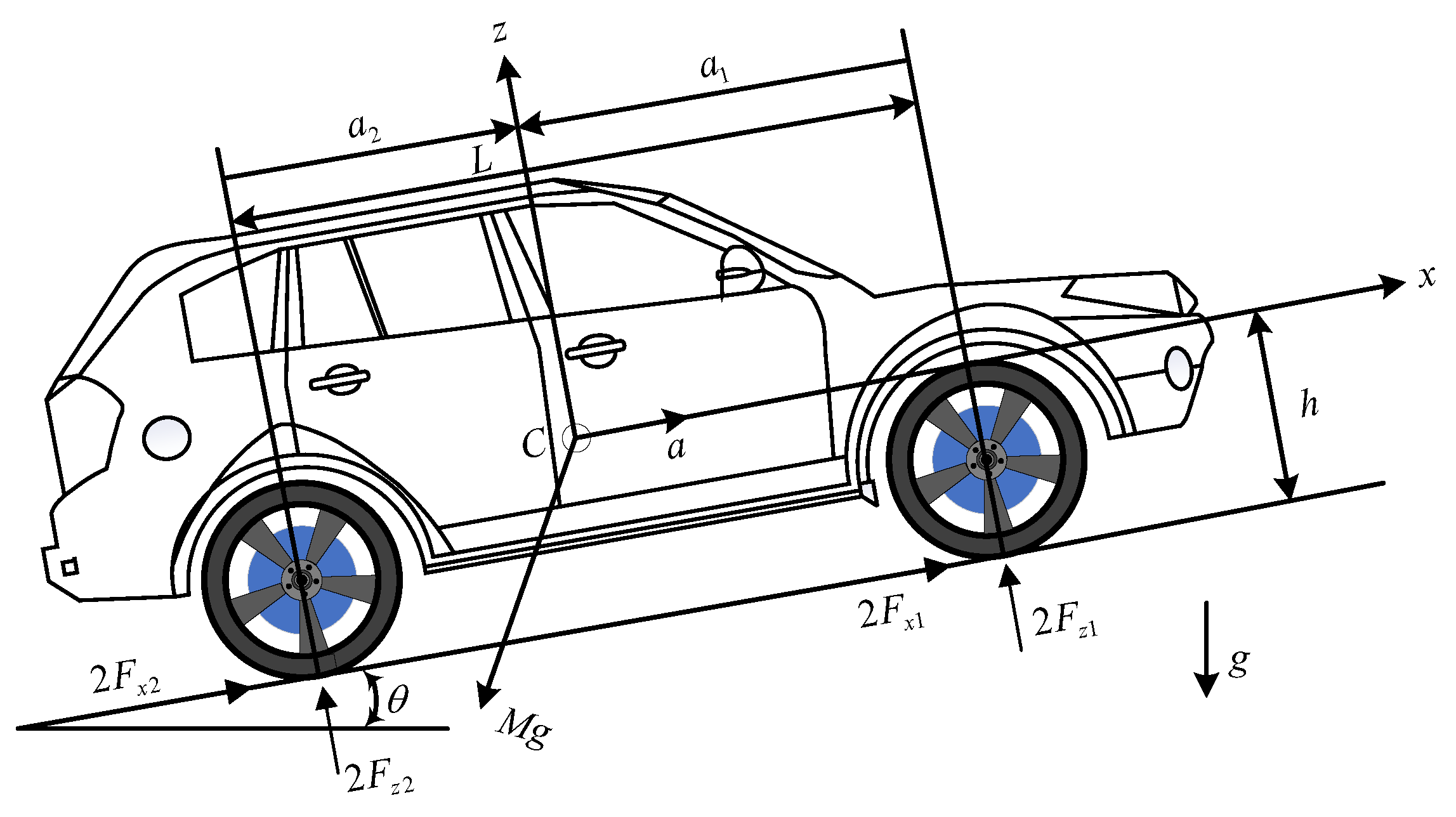
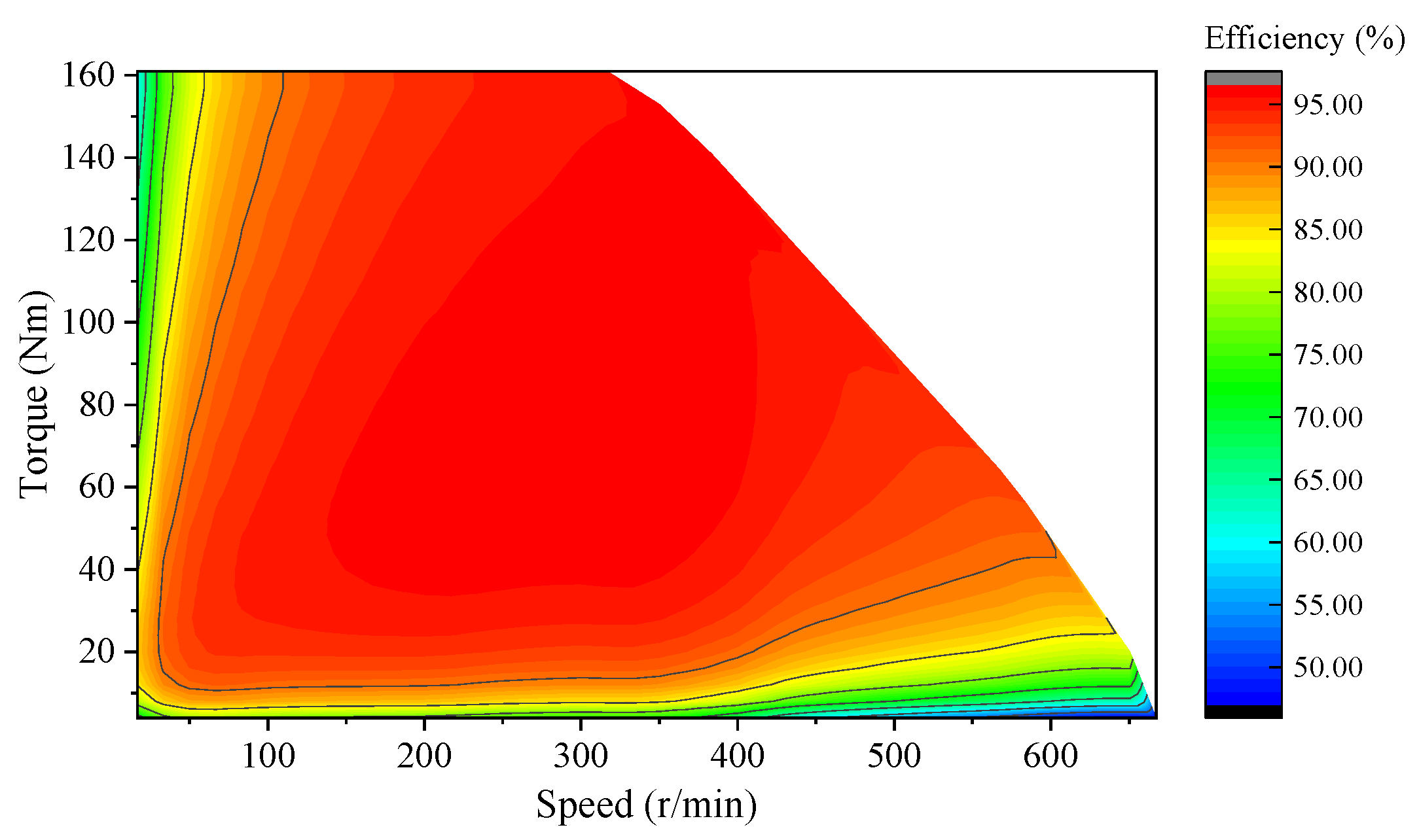
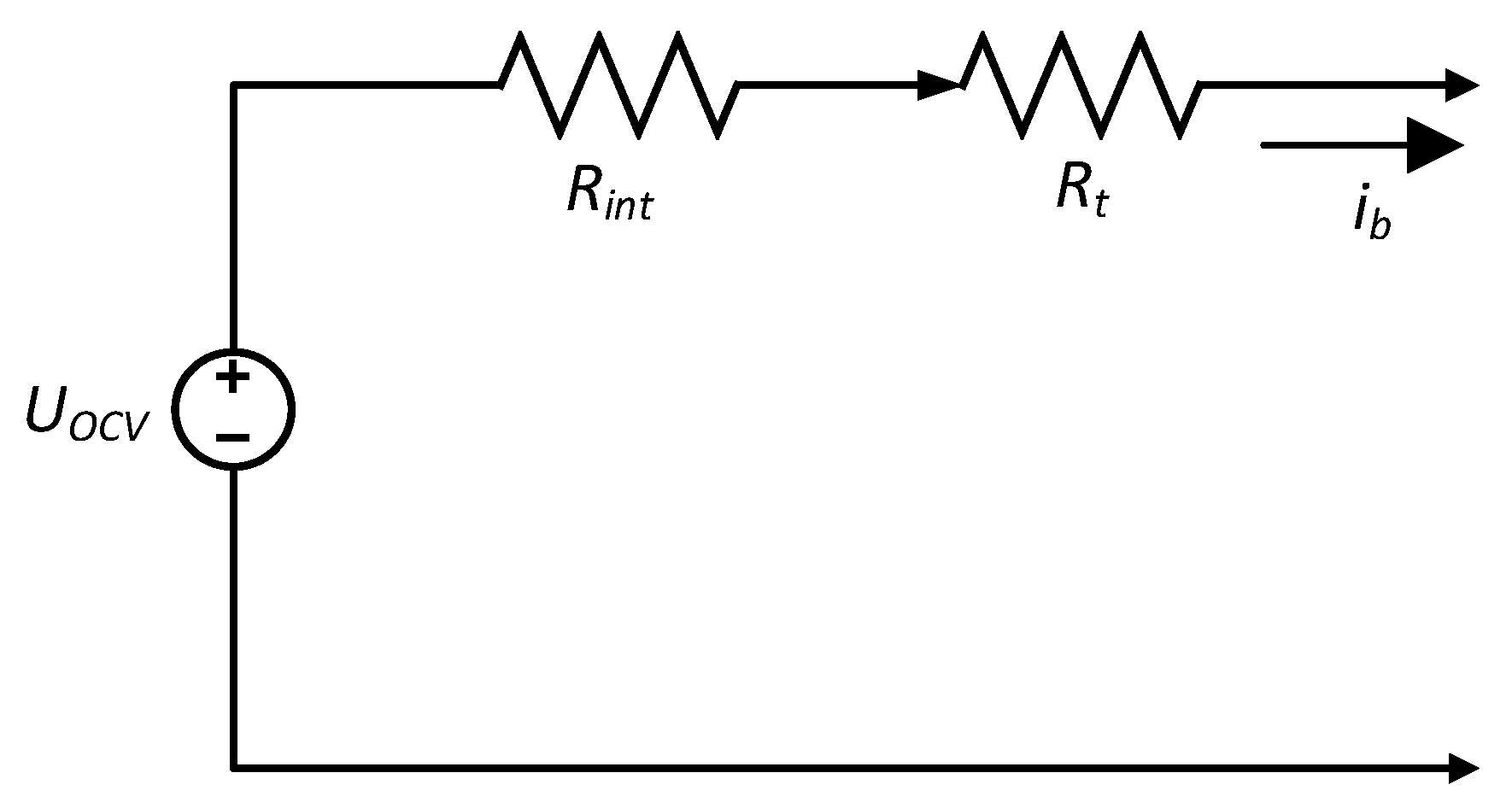
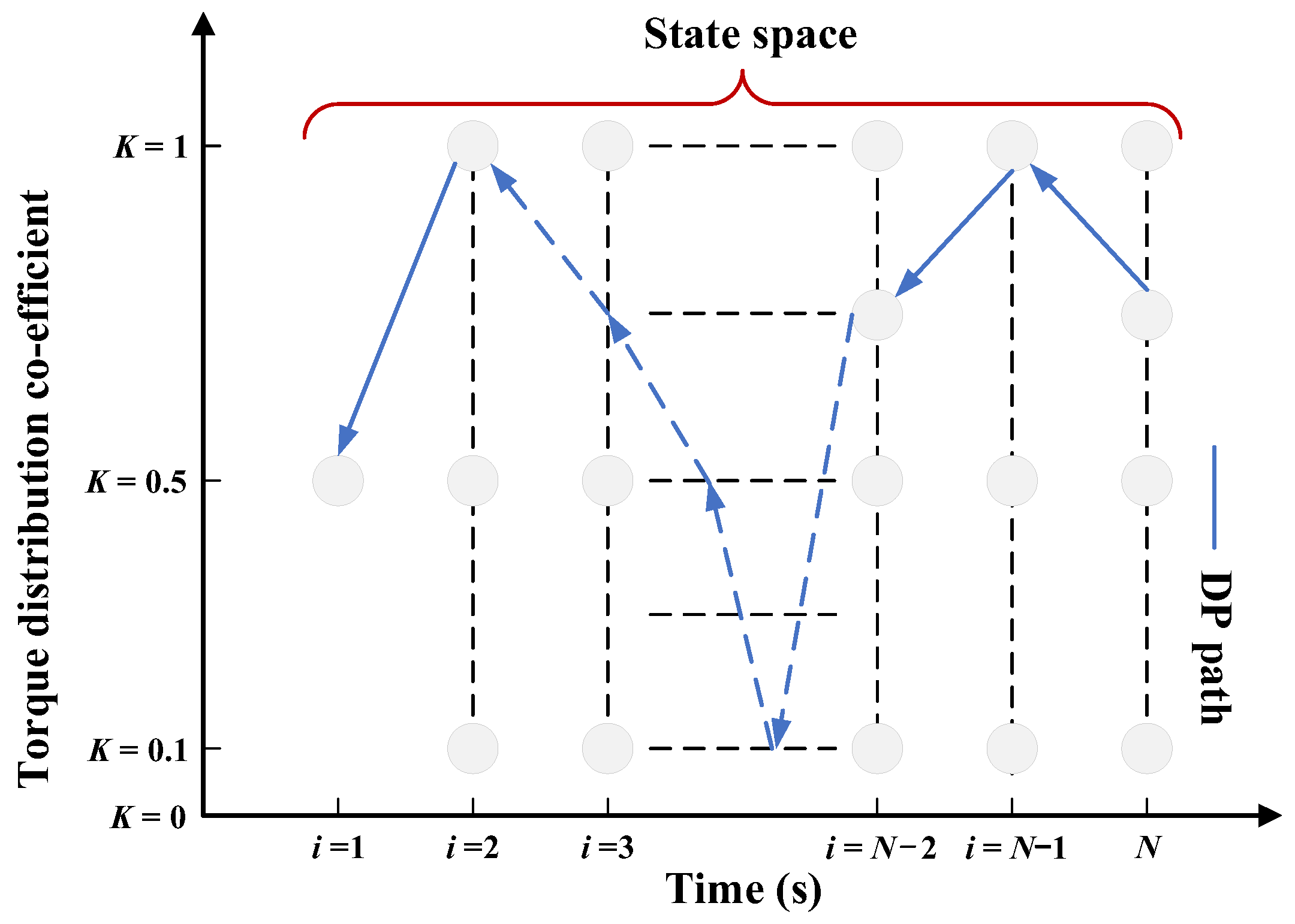
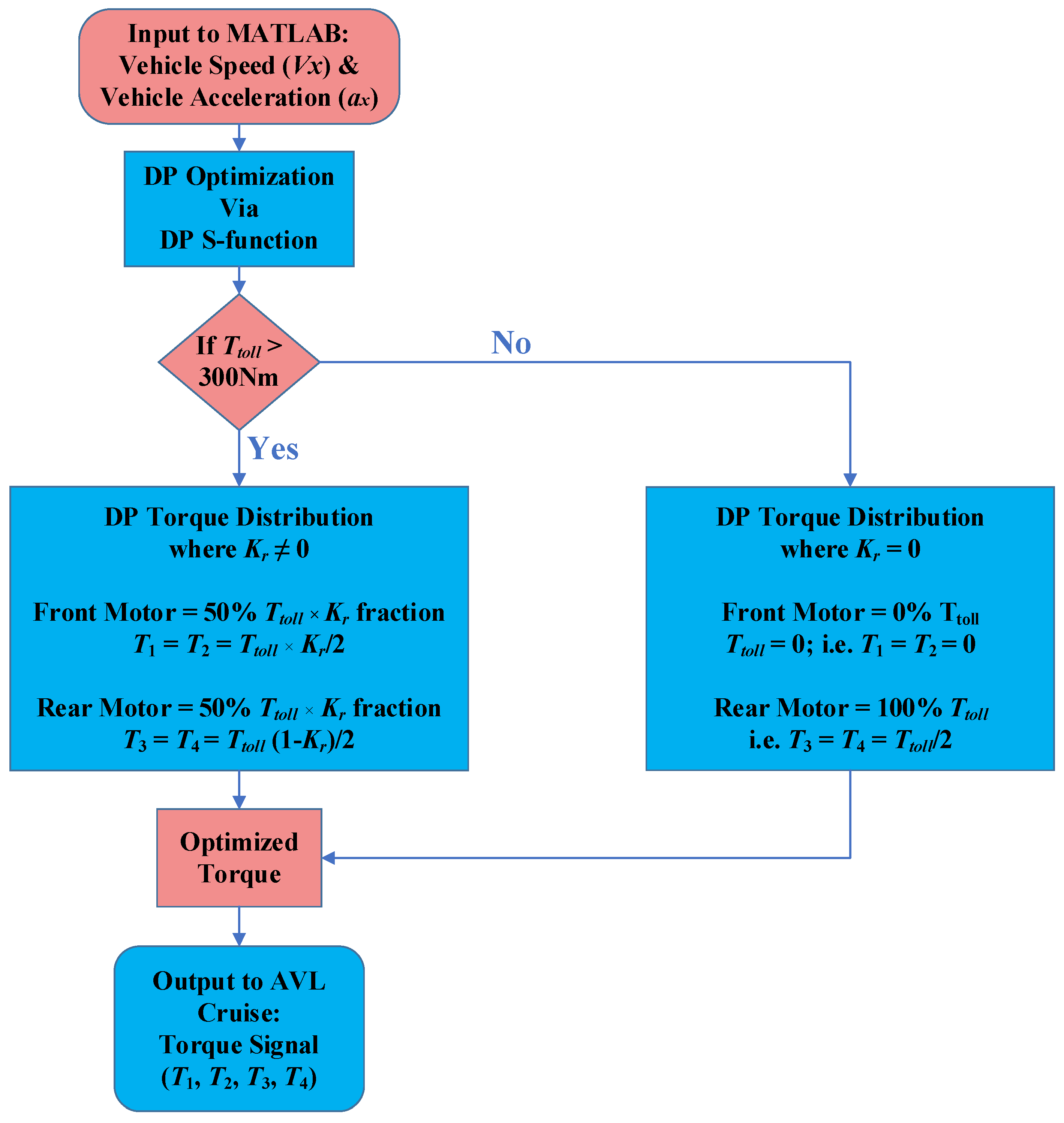
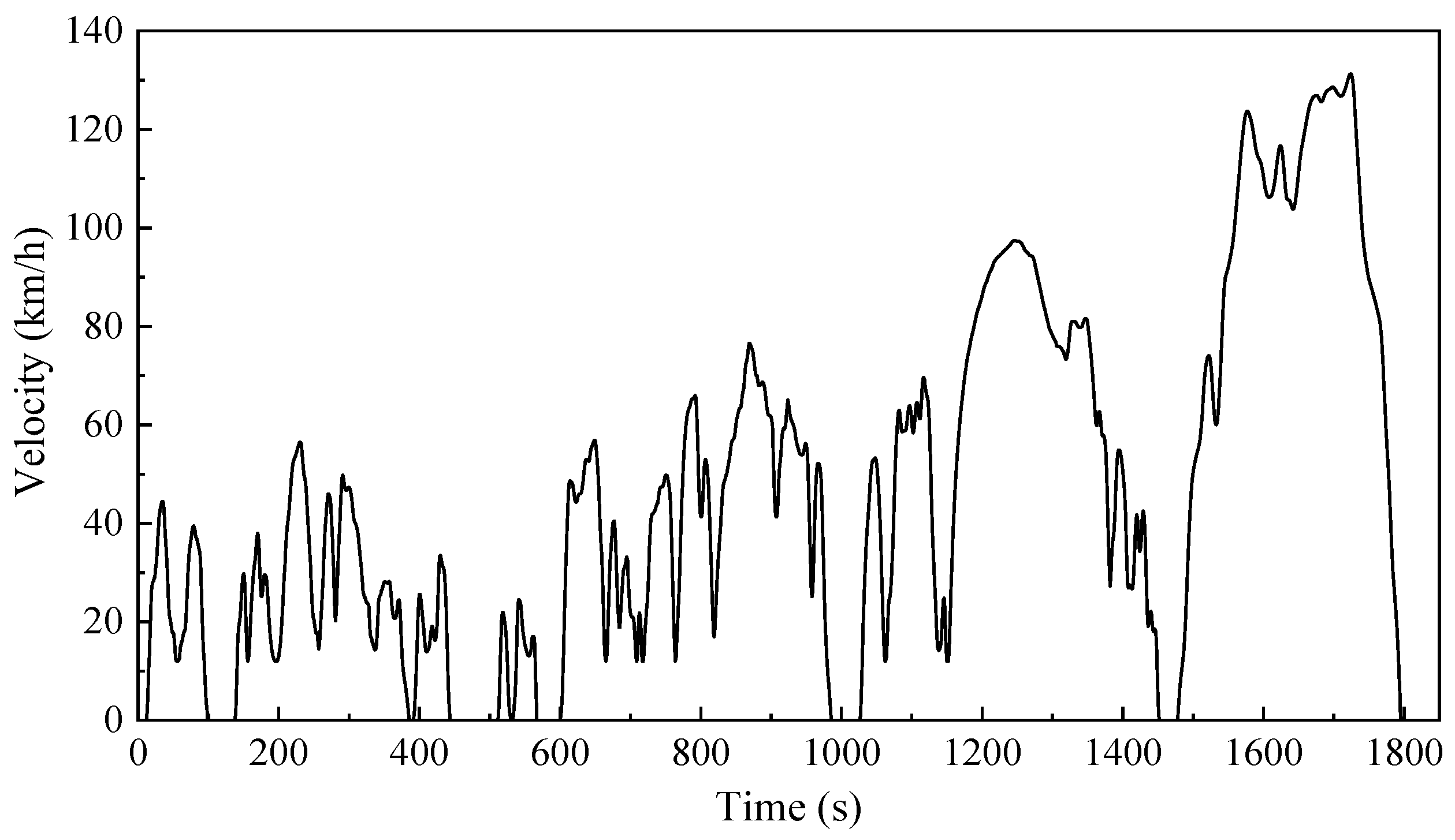
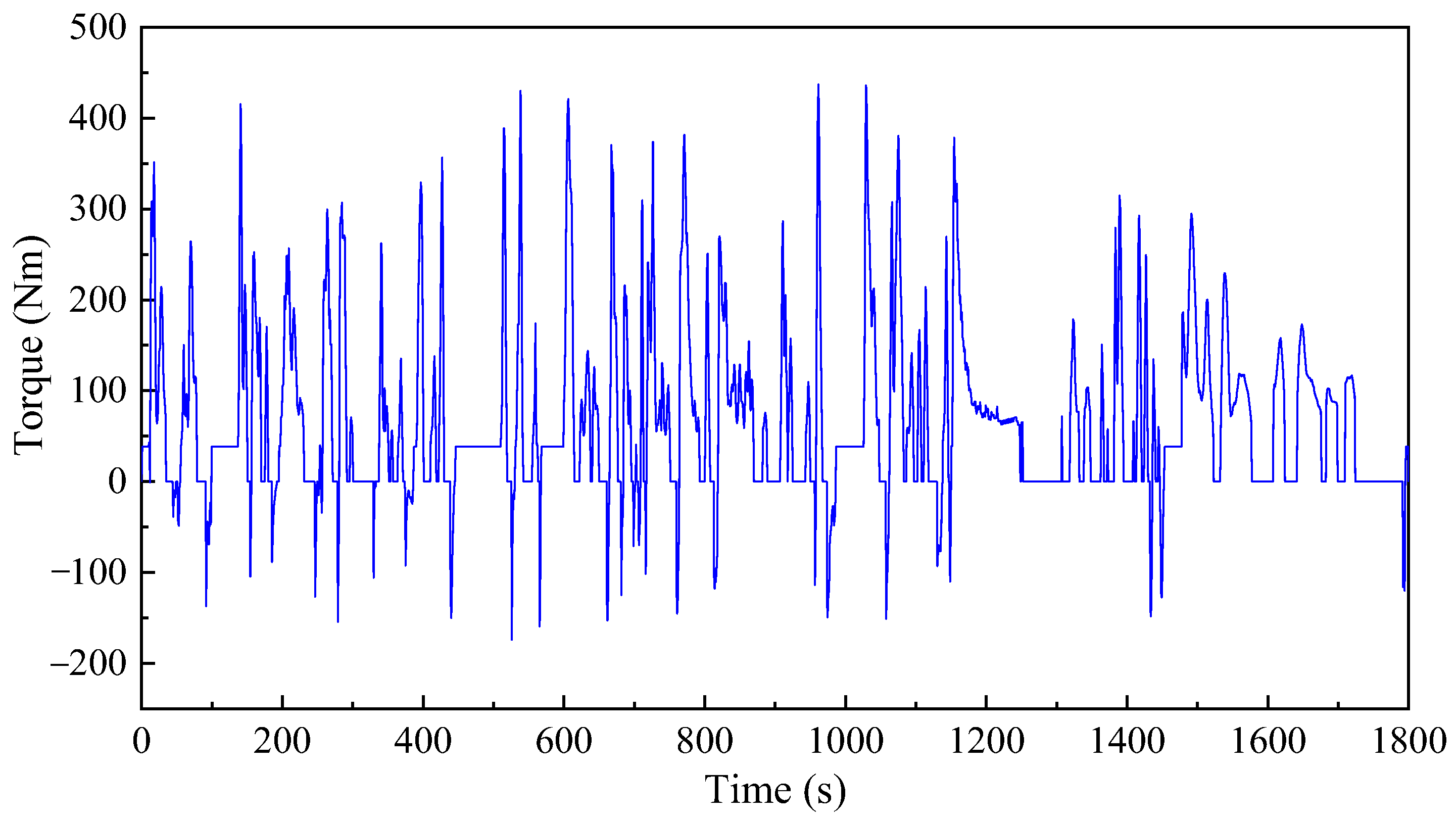

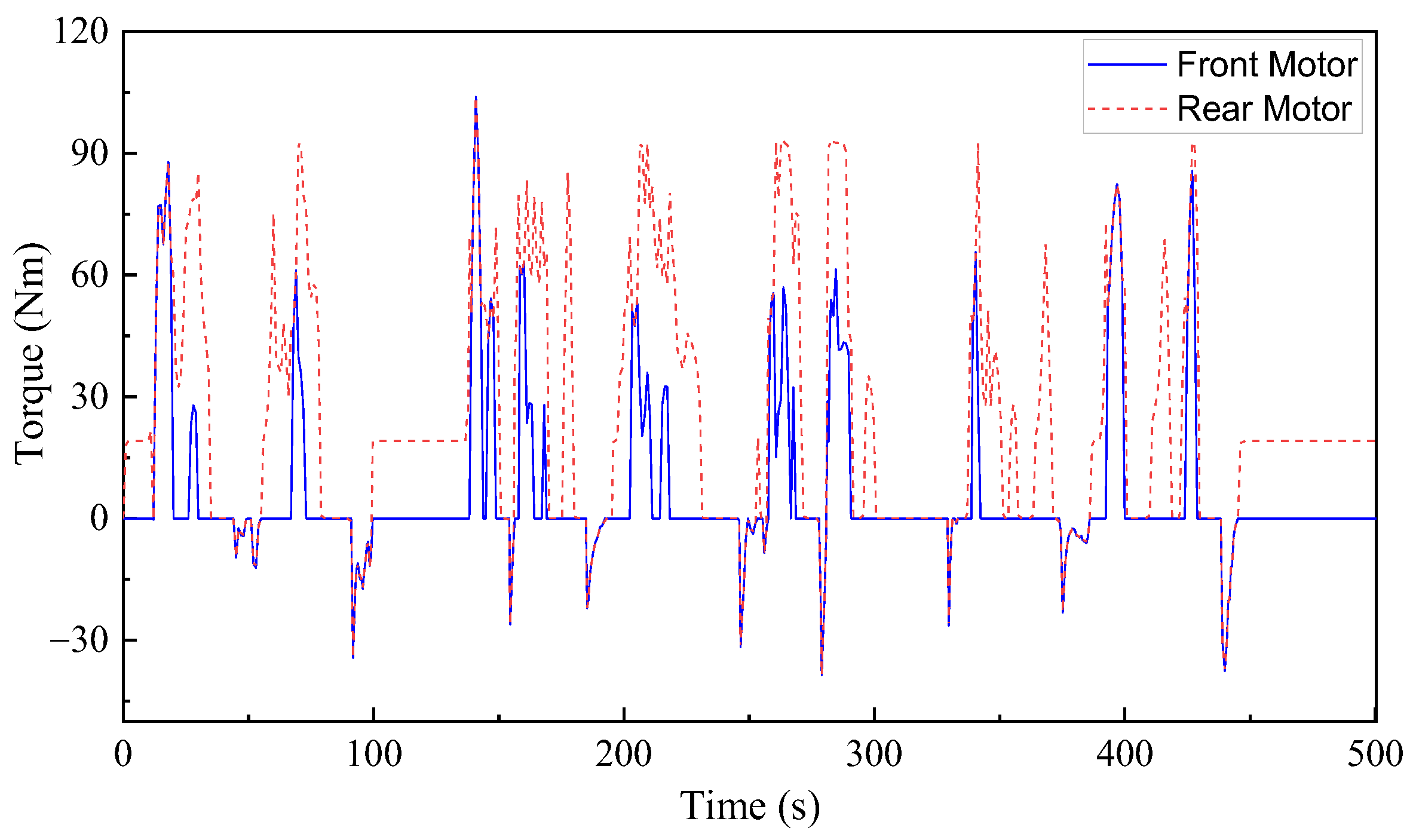

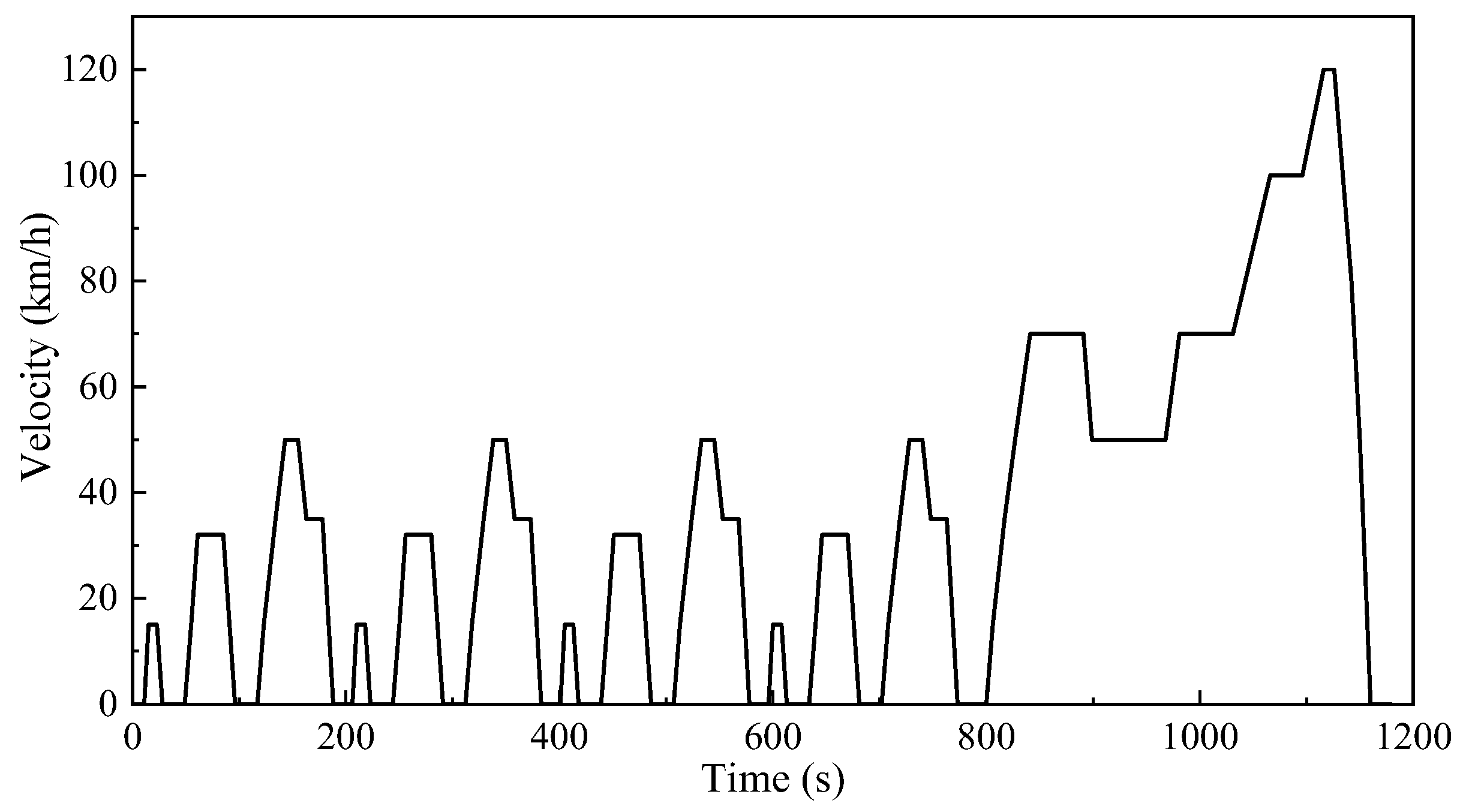





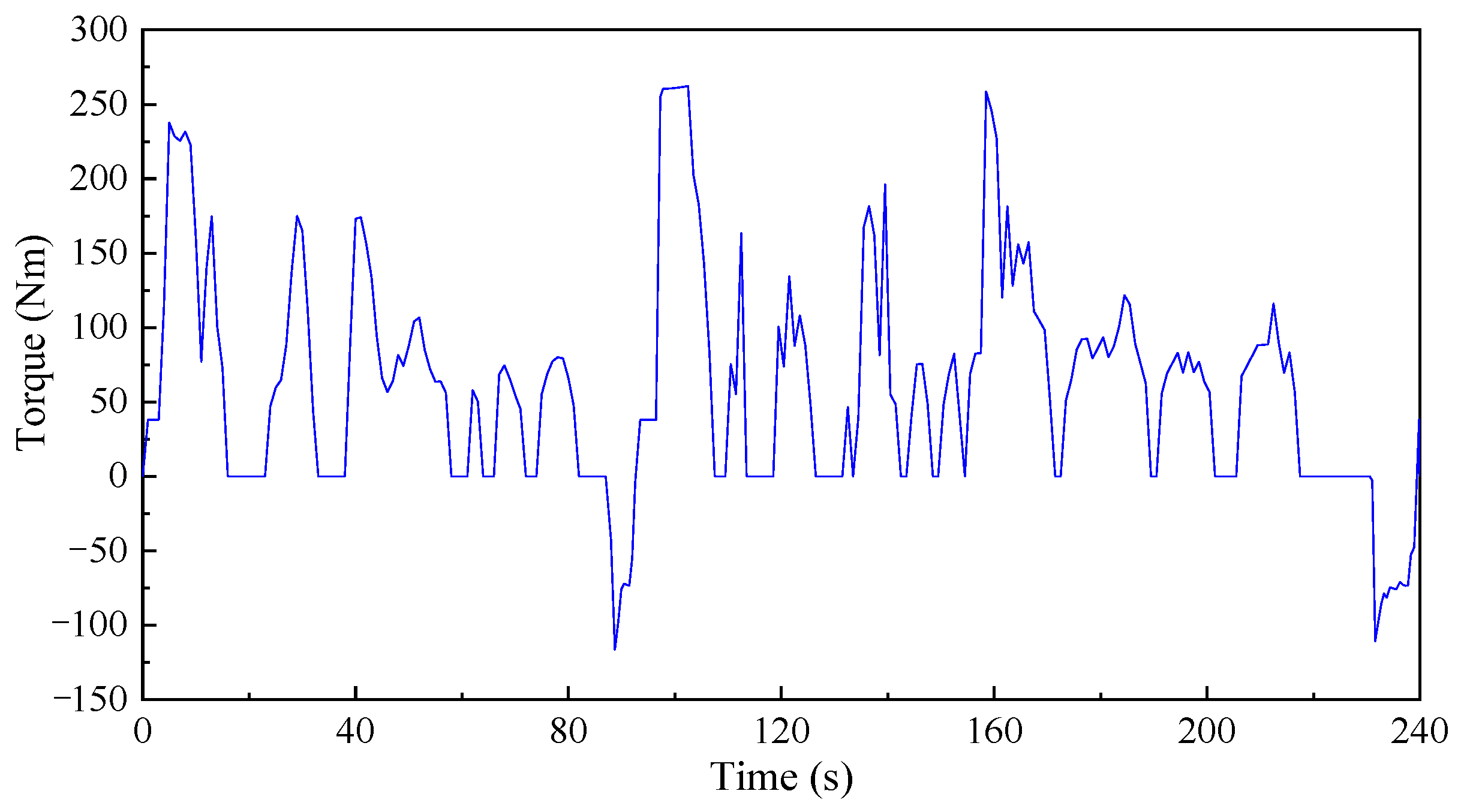


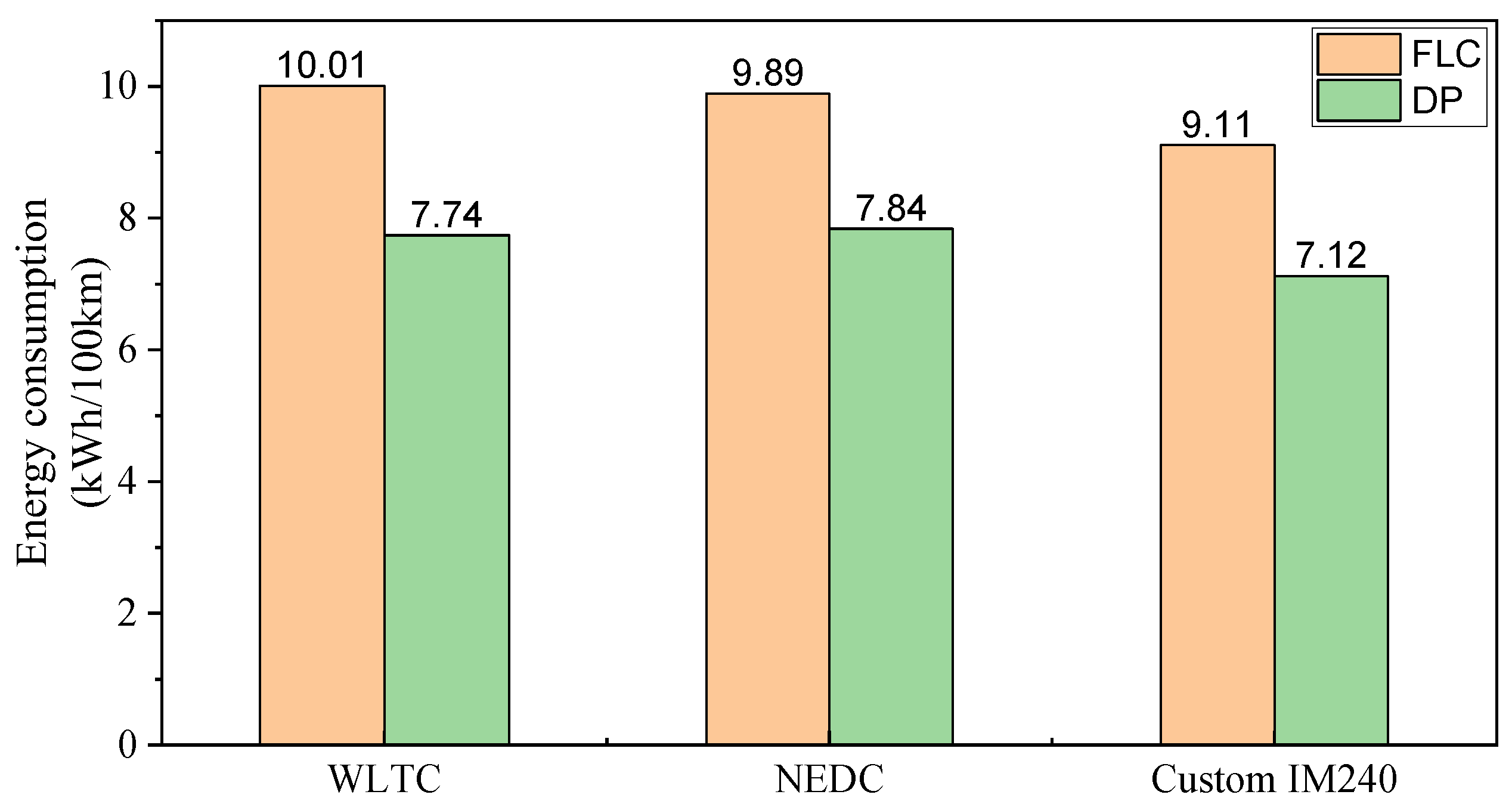
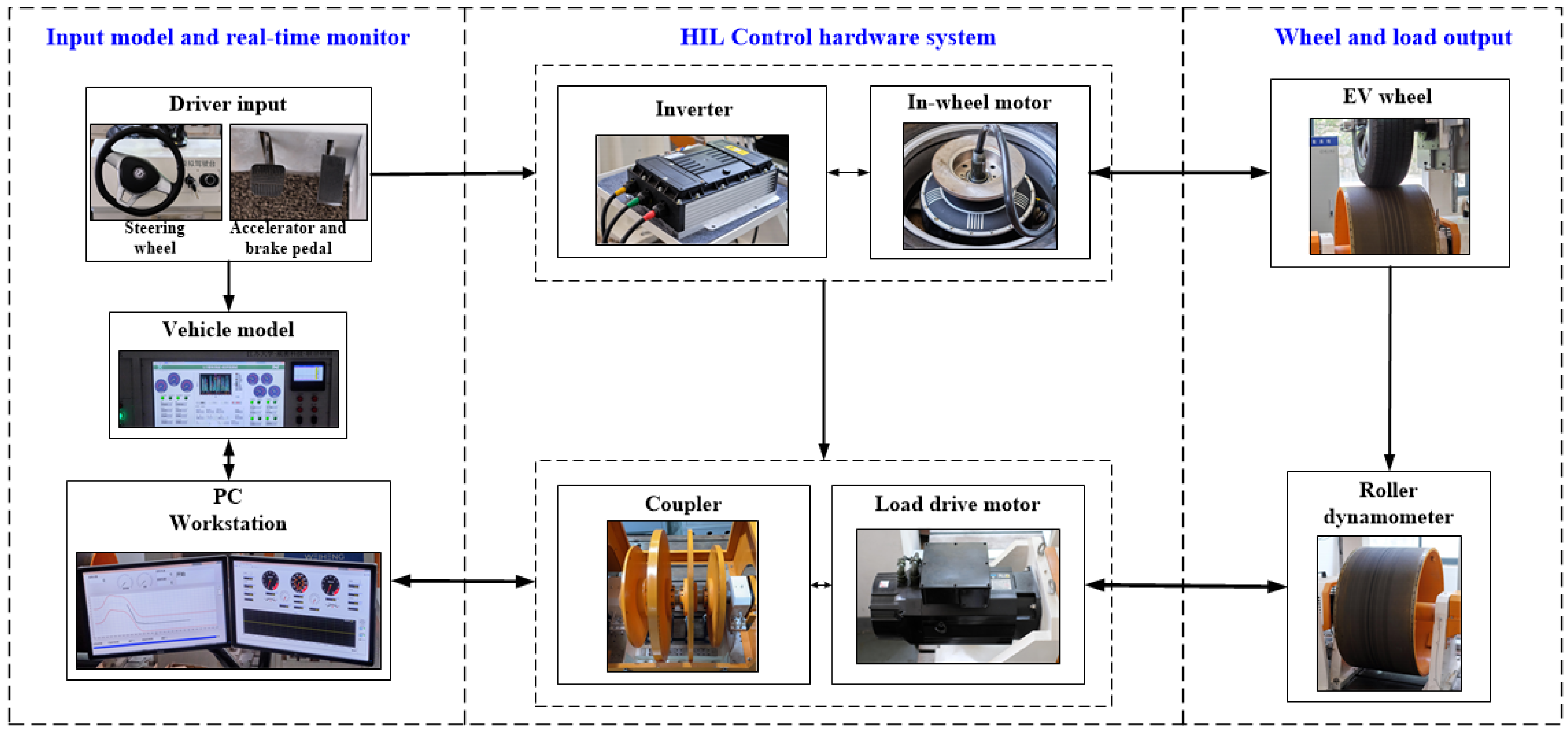






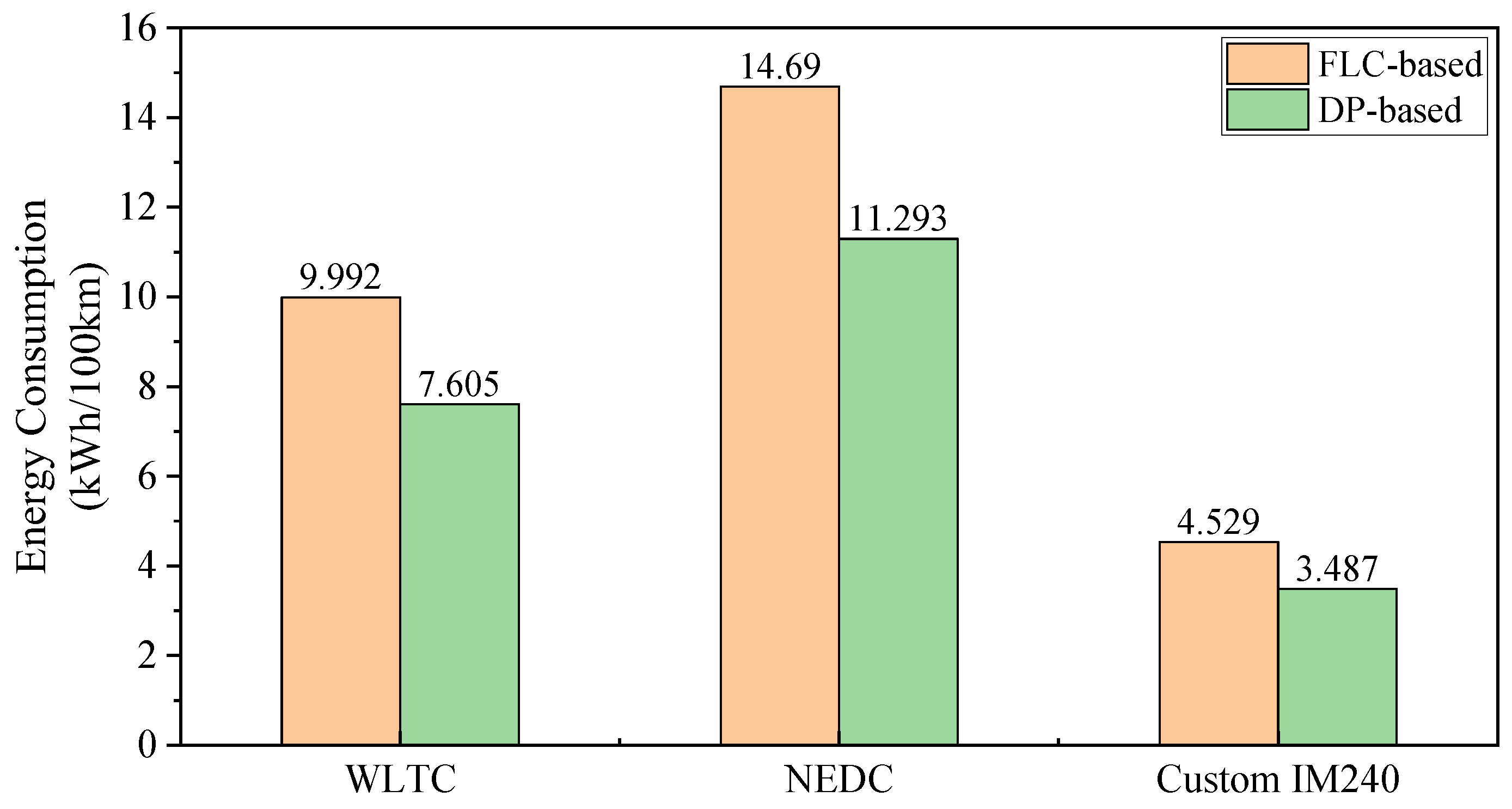
| Vehicle Parameter | Symbol | Value (Unit) |
|---|---|---|
| Curb weight | M | 1270 kg |
| Coefficient of rolling friction | Cr | 0.017 |
| Cross-sectional area | A | 1.97 m2 |
| Aerodynamic drag coefficient | CD | 0.35 |
| Rolling radius | R | 0.31 m |
| In-Wheel Motor Parameter | Value (Unit) |
|---|---|
| Rated voltage | 72 V |
| Rated current | 110 A |
| Maximum speed | 1200 rpm |
| Rated power | 8 kW |
| Rated frequency | 50 Hz |
| Maximum torque | 250 Nm |
| FLC-Based Torque Distribution Energy Consumption (kWh/100 km) | DP-Based Torque Distribution Energy Consumption (kWh/100 km) | Improvement in Energy Consumption (%) | |
|---|---|---|---|
| WLTC | 10.01 | 7.74 | 22.68 |
| NEDC | 9.89 | 7.84 | 20.73 |
| Custom IM240 | 9.11 | 7.12 | 21.84 |
| Energy Consumption with FLC Algorithm (kWh/100 km) | Energy Consumption with DP Algorithm (kWh/100 km) | Improvement in Energy Consumption (%) | |
|---|---|---|---|
| WLTC | 9.992 | 7.605 | 23.89 |
| NEDC | 14.690 | 11.293 | 23.12 |
| Custom IM240 | 4.529 | 3.487 | 23.01 |
Publisher’s Note: MDPI stays neutral with regard to jurisdictional claims in published maps and institutional affiliations. |
© 2022 by the authors. Licensee MDPI, Basel, Switzerland. This article is an open access article distributed under the terms and conditions of the Creative Commons Attribution (CC BY) license (https://creativecommons.org/licenses/by/4.0/).
Share and Cite
Adeleke, O.P.; Li, Y.; Chen, Q.; Zhou, W.; Xu, X.; Cui, X. Torque Distribution Based on Dynamic Programming Algorithm for Four In-Wheel Motor Drive Electric Vehicle Considering Energy Efficiency Optimization. World Electr. Veh. J. 2022, 13, 181. https://doi.org/10.3390/wevj13100181
Adeleke OP, Li Y, Chen Q, Zhou W, Xu X, Cui X. Torque Distribution Based on Dynamic Programming Algorithm for Four In-Wheel Motor Drive Electric Vehicle Considering Energy Efficiency Optimization. World Electric Vehicle Journal. 2022; 13(10):181. https://doi.org/10.3390/wevj13100181
Chicago/Turabian StyleAdeleke, Oluwatobi Pelumi, Yong Li, Qiang Chen, Wentao Zhou, Xing Xu, and Xiaoli Cui. 2022. "Torque Distribution Based on Dynamic Programming Algorithm for Four In-Wheel Motor Drive Electric Vehicle Considering Energy Efficiency Optimization" World Electric Vehicle Journal 13, no. 10: 181. https://doi.org/10.3390/wevj13100181
APA StyleAdeleke, O. P., Li, Y., Chen, Q., Zhou, W., Xu, X., & Cui, X. (2022). Torque Distribution Based on Dynamic Programming Algorithm for Four In-Wheel Motor Drive Electric Vehicle Considering Energy Efficiency Optimization. World Electric Vehicle Journal, 13(10), 181. https://doi.org/10.3390/wevj13100181








